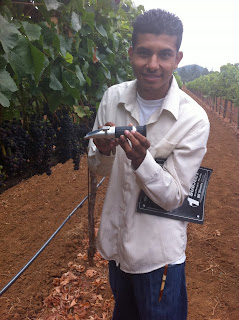of Sonoma County
is one wine tasting each week at a new winery!
I chose Martinelli Winery first because of their proximity to Shone Farm, and also because I'm trying to get their approval to "monitor and observe" one of their vineyards for a class project over a period of a few months. George Martinelli (described by my teacher as handsome and resembling Paul Newman - and wow, was she not exaggerating!) was gracious enough to meet with me for a few minutes today (everyone is super busy w/harvest at this time of year) and hopefully he will be able to spend part of tomorrow morning showing me around. I'm also hoping he will take me under his proverbial wing and maybe teach me something I can't learn from my school textbooks or classroom lectures. Maybe I can even get an internship or - dare I say it - a job, somewhere down the line...
On the way out I stopped in the tasting room where Denise and Judy were friendly and knowledgeable and because I mentioned I was a Vit student at the JC, I got my tasting fee waived...I sampled two Chardonnays, one Pinot, one Zin and one dessert wine. My favorite was the 2008 Vigneto di Evo Zinfandel: "layers of blackberry, kirsch, roasted figs...long lingering finish" - it comes from a tiny vineyard which is the site of the original family homestead ranch. Excellent at $30. My second favorite was the 2008 Muscat Alexandria, a honeysuckle, jasmine. honey and vanilla delight that would be great during the holidays - also reasonable at $28. The Martinelli family has been in Sonoma County since 1860, starting by raising sheep, cattle, potatoes, walnuts, prunes, apples, and finally wine grapes. They specialize in producing small lots of wine from single vineyards. I loved the tasting room, which is situated in a big, red, historic hop barn. Worth a visit.

